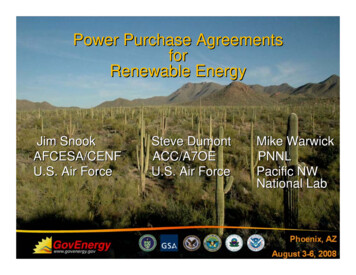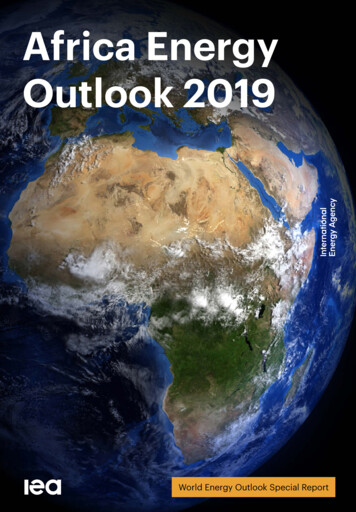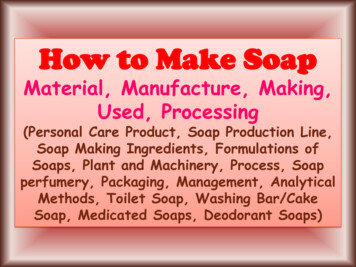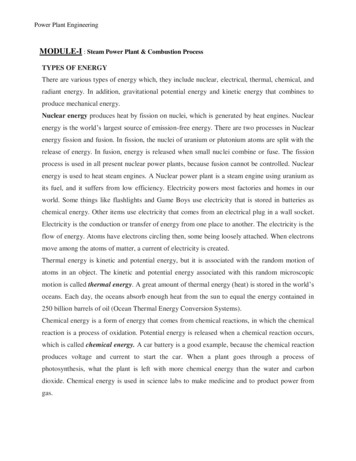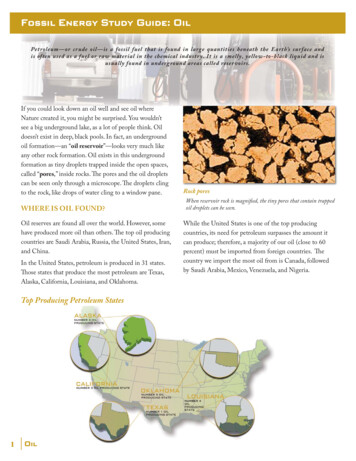
Transcription
Fossil Energy Study Guide: OilPet roleum—or cr ude oil—is a fossil fuel that is found in large quantities beneath the Earth’s sur face andis often used as a fuel or raw material in the chemical indust r y. It is a smelly, yellow-to-black liquid and isusually found in underg round areas called reser voirs.If you could look down an oil well and see oil whereNature created it, you might be surprised. You wouldn’tsee a big underground lake, as a lot of people think. Oildoesn’t exist in deep, black pools. In fact, an undergroundoil formation—an “oil reservoir”—looks very much likeany other rock formation. Oil exists in this undergroundformation as tiny droplets trapped inside the open spaces,called “pores,” inside rocks. The pores and the oil dropletscan be seen only through a microscope. The droplets clingto the rock, like drops of water cling to a window pane.WHERE IS OIL FOUND?Oil reserves are found all over the world. However, somehave produced more oil than others. The top oil producingcountries are Saudi Arabia, Russia, the United States, Iran,and China.In the United States, petroleum is produced in 31 states.Those states that produce the most petroleum are Texas,Alaska, California, Louisiana, and Oklahoma.Top Producing Petroleum States1OilRock poresWhen reservoir rock is magnified, the tiny pores that contain trappedoil droplets can be seen.While the United States is one of the top producingcountries, its need for petroleum surpasses the amount itcan produce; therefore, a majority of our oil (close to 60percent) must be imported from foreign countries. Thecountry we import the most oil from is Canada, followedby Saudi Arabia, Mexico, Venezuela, and Nigeria.
Fossil Energy Study Guide: OilUSES FOR PETROLEUMYou are probably already familiar with the main use forpetroleum: gasoline. It is used to fuel most cars in theUnited States. But petroleum is also used to make manymore products that we use on a daily basis.A majority of petroleum is turned into an energy source.Other than gasoline, petroleum can also be used to makeheating oil, diesel fuel, jet fuel, and propane. It can also beturned into petrochemical feedstock—a product derivedfrom petroleum principally for the manufacturing ofchemicals, synthetic rubber, and plastics. It is also usedto make many common household products, includingcrayons, dishwashing liquids, deodorant, eyeglasses, tires,and ammonia.DRILLING FOR OIL—EXPLORATIONThe first step to drilling for oil is knowing where to drill.Because it is an expensive endeavor, oil producers need toknow a lot about an oil reservoir before they start drilling.They need to know about the size and number of pores ina reservoir rock, how fast oil droplets will move throughthe pores, as well as where the natural fractures are in areservoir so that they know where to drill.While in the past it may have taken a few guesses andsome misses to find the right place to drill, scientists havediscovered new ways to determine the right locations foroil wells. Using sound waves, scientists can determine thecharacteristics of the rocks underground. Sound travelsat different speeds through different types of rocks. Bylistening to sound waves using devices called “geophones,”scientists can measure the speed at which the soundwaves move through the rock and determine where theremight be oil-bearing rocks. Scientists can also use electriccurrents in place of the sound waves for the same effect.Scientists can also examine the rock itself. An exploratorywell will be drilled and rock samples called “cores” will bebrought to the surface. The samples will be examined under amicroscope to see if oil droplets are trapped within the rock.2OilOther Distillates(heating oil) —1.38Heavy Fuel Oil(residual) —1.68LiquefiedPetroleumGases (LPG) —1.72Source: Energy Information AdministrationProducts Made from a Barrel of Crude Oil (gallons)Note: A 42-U.S. gallon barrel of crude oil yields between 44 and 45gallons of petroleum products.DRILLING FOR OIL—PRIMARYRECOVERYOnce the oil producers are confident they have found theright kind of underground rock formation, they can begindrilling production wells.When the well first hits the reservoir, some of the oil maycome to the surface immediately due to the release ofpressure in the reservoir. Pressure from millions of tonsof rock lying on the oil and from the earth’s natural heatbuild up in the reserve and expand any gases that may bein the rock. When the well strikes the reserve, this pressureis released, much like the air escaping from a balloon. Thepressure forces the oil through the rock and up the well tothe surface. Years ago, when the equipment wasn’t as good,it was sometimes difficult to prevent the oil from spurtinghundreds of feet out of the ground in a “gusher.” Today,however, oil companies install special equipment on theirwells called “blowout preventers” that prevents the gushersand helps to control the pressure inside the well.When a new oil field first begins producing oil, the naturalpressures in the reservoir force the oil through the rock
Fossil Energy Study Guide: Oilpores, into fractures and up production wells. This naturalflow of oil is called “primary production.” It can go onfor days or years. But after a while, an oil reservoir beginsto lose pressure. The natural oil flow begins dropping offand oil companies must use pumps to bring the oil to thesurface.It is not uncommon for natural gas to be found along withthe petroleum. Oil companies can separate the gas fromthe oil and inject it back into the reservoir to increase thepressure to keep the oil flowing. But sometimes this is notenough to keep the oil flowing and a lot of oil will be leftbehind in the ground. Secondary recovery is then used toincrease the amount of oil produced from the well.DRILLING FOR OIL—SECONDARYRECOVERYImagine spilling a can of oil on a concrete floor. Youwould be able to wipe some of it up, but a thin film ofoil might be left on the floor. You could take a hose andspray the floor with water to wash away some of theoil. This is basically what oil producers can do to an oilreservoir during secondary recovery. They drill wells called“injection wells” and use them like gigantic hoses topump water into an oil reservoir. The water washes someof the remaining oil out of the rock pores and pushes itthrough the reservoir to production wells. This is called“waterflooding.”Let’s assume that an oil reservoir had 10 barrels of oil in itat the start (an actual reservoir can have millions of barrelsof oil). This is called “original oil in place.” Of those original10 barrels, primary production will produce about two and ahalf barrels. Waterflooding will produce another one-half toone barrel. That means that in our imaginary oil reservoir of10 barrels, there will still be six and a half to seven barrels ofoil left behind after primary production and waterflooding.In other words, for every barrel of oil we produce, we willleave around two barrels behind in the ground.This is the situation facing today’s oil companies. In thehistory of the United States oil industry, more than 1953OilInjection wellsSteam is injected into many oil fields where the oil is thicker andheavier than normal crude oil.billion barrels of oil have been produced but more than 400billion barrels have been left in the ground.DRILLING FOR OIL—ENHANCED OILRECOVERYPetroleum scientists are working on ways to extract thehuge amounts of oil that are left behind after primary andsecondary production. Through enhanced oil recovery(EOR) techniques, it may be possible to produce 30 to60 percent of the reservoir’s original oil in place. Currentresearch in EOR techniques includes:
Fossil Energy Study Guide: Oil Thermal recovery, which involves the introductionof heat such as the injection of steam to lowerthe viscosity, or thin, the heavy viscous oil, andimprove its ability to flow through the reservoir.Thermal techniques account for more than 50percent of U.S. EOR production, primarily inCalifornia. Gas injection, which uses gases such as naturalgas, nitrogen, or carbon dioxide that expand in areservoir to push additional oil to a productionwellbore, or othergases that dissolvein the oil to lowerits viscosity andimprove its flowrate. Gas injectionaccounts for nearly50 percent of EORproduction in theUnited States. formations can provide sites for storage of CO2 producedfrom the combustion of fossil fuels in power plants andother processes that generate large amounts of CO2. Bycapturing the CO2 emissions from these sources andthen pumping it into depleting oil reservoirs, we not onlyincrease the production from the well but store the CO2underground to prevent it from being released to theatmosphere, where it may affect the climate. The potentialfor CO2 sequestration in depleted oil and gas reservoirs isenormous. The Department of Energy has documentedthe location of more than 152 billion tons of sequestrationpotential in the UnitedStates and Canada fromCO2-EOR. Currently,about 48 million tons ofmostly naturally produceCO2 are injected annuallyfor EOR operations in theUnited States.REFINING OILChemicalWhen crude oil is removedinjection, whichfrom the ground, it doescan involve theInside an Oil Refinerynot come out in a form that isuse of long-chainedAn engineer stands inside an oil refinery surrounded by pipelinesreadily useable. Before it canand pumps.molecules calledbe used, it must be refined,polymers to increasewhere it is cleaned and separated into parts to create thethe effectiveness of waterfloods, or the use ofvarious fuels and chemicals made from oil. Within thedetergent-like surfactants to help lower the surfaceoil are different hydrocarbons which have various boilingtension that often prevents oil droplets frompoints, meaning they can be separated through distillation.moving through a reservoir. Chemical techniquesTo do this, the oil is piped through hot furnaces and basedaccount for less than 1 percent of U.S. EORon the hydrocarbon’s weight and boiling point, variousproduction.liquids and vapors will be created. The lightest components,The EOR technique that is attracting the most interest issuch as gasoline, will vaporize and rise to the top, wherecarbon dioxide (CO2)-EOR. Injecting CO2—the samethey will condense and turn back into liquids. The heaviergas that gives soda pop its fizz—into an oil reservoircomponents will sink to the bottom. This will allow thethins crude oil left behind, pressurizes it, and helps movecomponents to be separated from each other and turnedit to producing wells. When all remaining economicallyinto their respective product or fuel.recoverable oil is produced, the reservoir and adjacentAfter the refinery, the gasoline and other fuels createdare ready to be distributed for use. A system of pipelines4Oil
Fossil Energy Study Guide: OilHISTORY OF PETROLEUMOffshore platformCurrently, there are more than 4,000 active platforms drilling foroil in the Gulf of Mexico.runs throughout the United States to transport oil andfuels from one location to another. There are pipelines thattransport crude oil from the oil well to the refinery. At therefinery, there are additional pipelines that transport thefinished product to various storage terminals where it canthen be loaded onto trucks for delivery, such as to a gasstation.1990for the first time, the UnitedStates imports more oil andrefined products than itproduces domestically.1970sProduction of petroleum in theUnited States’ lower 48 statesreaches its highest level of9.4 million barrels per day.1950sOil becomes our most used energysource due to the demandfor gasoline.1920sWith more than 9 millionautomobiles on the roads inthe United States, gas stationsbegin opening.1890sMass production of automobilesbegins, creating a demandfor gasoline.1859First oil well drilled nearTitusville, Pennsylvania,by Edwin L. Drake.Mid-Expanding uses for oil extractedfrom coal and shale begin toincrease the knowledge of thevalue of crude oil andexploration for it is encouraged.1800sOFFSHORE DRILLINGSometimes the oil is located deep underneath the ocean floorand offshore drilling must be used to extract the crude oil.A platform is built to house the equipment needed to drillthe well; the type of platform used will depend on a varietyof characteristics of the location, including the depth of thewater and how far underwater the drilling target is located. Ablowout preventer is used just like on wells built on land. Thishelps prevent petroleum from leaking out of the well and intothe water.Currently, there are more than 4,000 active platforms drillingfor oil in the Gulf of Mexico. While a majority of them arelocated in waters less than 200 meters (650 feet) in depth,nearly 30 are located in areas where the water is more than800 meters (2,400 feet) in depth.5Oil1750Oil is found in Pennsylvania andNew York by well-owners who aredigging for salt brine. However,its uses are little known atthis point.2000 B.C. The Chinese use crude oil tolight lamps and heat homes.
Fossil Energy Study Guide: OilSTORING THE OILAt the SPR sites, the crude oil is stored in undergroundsalt caverns. Salt caverns are carved out of undergroundsalt domes by a process called “solution mining.”Essentially, the process involves drilling a well into asalt formation then injecting massive amounts of freshwater. The water dissolves the salt. In creating the SPRcaverns, the dissolved salt was removed as brine and eitherreinjected into disposal wells or more commonly, pipedseveral miles offshore into the Gulf of Mexico. By carefullycontrolling the freshwater injection process, salt caverns ofvery precise dimensions can be created.Strategic Petroleum ReserveA technician at the Strategic Petroleum Reserve inspects crude oiltransfer pipes.STRATEGIC PETROLEUM RESERVEOil is a very important commodity to the United States. Itfuels our cars and buses, as well as the machines at manyfactories and refineries. With a majority of the oil we usetoday being imported, what would happen if we weren’table to get enough oil to keep up with the demand? An oilembargo in the 1970s cut off the supply of oil imported tothe United States from the Middle East leading to longlines at the gas stations and even some fuel shortages.While the idea of creating a stockpile had come up before,the embargo helped cement the idea that an oil reserve wasin fact needed.Besides being the lowest cost way to store oil for longperiods of time, the use of deep salt caverns is also one ofthe most environmentally secure. At depths ranging from2,000 to 4,000 feet (610 – 1,220 meters), the salt walls ofthe storage caverns are “self-healing.” The extreme geologicpressures make the walls rock hard, and should any cracksdevelop in the walls, they would be almost instantly closed.An added benefit of deep salt cavern storage is the naturaltemperature difference between the top of the caverns and theIn 1975, Congress passed the Energy Policy andConservation Act, which made it policy of the UnitedStates to establish a reserve of up to 1 billion barrels ofcrude oil. By 1977, oil was being delivered to the newStrategic Petroleum Reserve (SPR). Currently, thereare four SPR sites located in Texas and Louisiana, whichhave a total capacity to hold 727 million barrels of crudeoil (filled as of December 2009), making it the largestemergency oil stockpile in the world.Oil StoragePipes at a refinery transport oil to its storage tanks.6Oil
Fossil Energy Study Guide: Oilbottom—a distance of around 2,000 feet. The temperaturedifferential keeps the crude oil continuously circulating in thecaverns, maintaining the oil at a consistent quality.The fact that oil floats on water is the underlying mechanismused to move oil in and out of the SPR caverns. Towithdraw crude oil, fresh water is pumped into the bottomof a cavern. The water displaces the crude oil to the surface.After the oil is removed from the SPR caverns, pipelinessend it to various terminals and refineries around the nation.FILLING THE SPROil for the SPR can be purchased by the government fromoil companies, as was done in the 1970s and the 1980s. Inthe late 1990s, the SPR also began using royalty-in-kindoil, which is oil that is given to the government by petroleumoperators as payment on leases they hold on the federallyowned Outer Continental Shelf in the Gulf of Mexico.Instead of paying for the leases with money, the companiesgive the government oil, which is then put into the reserves.Using the SPRUSING THE SPRThere have been two emergency drawdowns from thereserve. The first took place in 1991 during the PersianGulf War. In order to maintain a stabilized petroleummarket during Operation Desert Storm, the governmentoffered 33 million barrels of oil from the SPR for sale;a little more than 17 million barrels were bought anddeliveries began within a month. The second emergencydrawdown occurred in 2005 after Hurricane Katrinadamaged oil refineries in the Gulf Coast region.In an emergency, when a limited nation’s oil supply leadsto an adverse impact on national safety or on the nationaleconomy, the president may order oil to be withdrawnfrom the reserve. The president can issue a full “drawdown”in which all the oil from the reserve is released. A limiteddrawdown may be issued in times where the eventthreatening national energy supplies and the economy isless severe or expected to be of short duration. A limiteddrawdown has restrictions on the amount of oil that can bereleased, as well as for how long.The president may also order a test sale, in which theprocess of releasing the oil into the marketplace is tested toensure all personnel know the procedures for a drawdownand all equipment is operational.In the event of a drawdown, the Department of Energy—which manages the SPR—will offer a specific number ofbarrels of crude oil from the reserve for sale. The departmentwill select those companies to sell to and can begin delivering7OilThe president can issue a drawdown (release of oil in the reserve)when events threaten national energy supplies.the oil within 13 days. Oil can be pumped from the reserveat a maximum rate of 4.4 million barrels per day for up to 90days before the drawdown rate begins declining as the cavernsempty out. At 1 million barrels per day, the reserve can releaseoil into the market continuously for nearly a year and a half.The Department of Energy is also authorized to exchangeoil from SPR. These exchanges have been used in the pastto replace less suitable types of crude oil for higher-qualitycrude oil. It has also been used for limited, short-durationactions to assist petroleum companies in resolving oildelivery problems, such as the CITGO/Conoco Exchangesin 2000, when a commercial dry dock collapsed, cutting offshipping channels to the refineries.
A majority of petroleum is turned into an energy source. Other than gasoline, petroleum can also be used to make heating oil, diesel fuel, jet fuel, and propane. It can also be turned into petrochemical feedstock—a product derived from petroleum principally for the manufacturing of c



